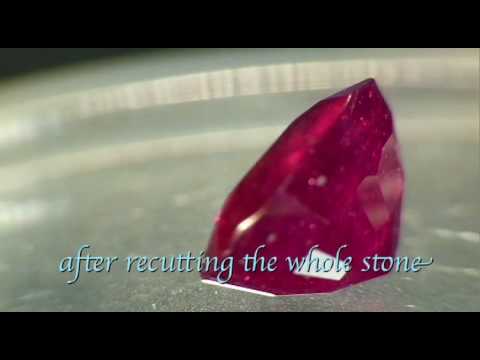I just purchased a couple of lead-heat treated Madagascar rubies.
What is the general opinion of lead-heat treated? And is the lead
process a danger to the wearer? I see in the Stuller catalog heat
treated rubies, but not lead-heat treated. If someone can explain
this to me, I would be grateful.
Hello Rick,
It’s not the Lead you have to worry about, it’s locked in glass and
poses the same health threat to the customer as fine lead crystal
tableware.
Your health on the other hand is in jeopardy, I have a growing
number of customers that have had these nasty things bite them big
time.
As a repair cutter I have had to repolish many of them. They are
filled with a soft glass and wear as well as any piece of soft glass
even though it has bits of Ruby in it. The damage is usually an
etched surface with white lines where the glass reaches the surface
and a severe loss in clarity and the colour becomes more greyish
purple.
Other than wearing it for a few weeks, it can also be damaged by
lemon juice, vinegar and some household cleaners. This type of
damage often has a law suit or other threats attached. Jewellers
losses are from polishing buffs, aggressive ultrasonics and pickle.
Usually a minor expense as they are very cheap, not if they belong to
a customer that heavily overpaid though.
Tony.
Anthony Lloyd-Rees.
www.TheGemDoctor.com
Beautiful British Columbia.
Hi Rick. Although glass is present in both lead glass filled ruby
(composite ruby) and traditionally heated ruby they are worlds apart
when it comes to stabilty/durablity and actual wholesale cost. In
traditionally “heated” ruby surface breaking feathers are filled with
minor amounts of molten “flux” which turns to glass after cooling
from the high temperature heating process. This is generally a low
refractive index glass and is reasonably stable to heat and acids
such as those used in rhodium plating and pickle. Lead glass filled
ruby (composite ruby) starts with extremely low grade corundum gravel
which is acid treated to remove everything that is not corundum,
leaving the corundum rough so porous that it is like sponge, this
corundum is so delicate that it often can not be pre-formed or cut at
all. it will simple crumble. So this porous rough corundum is then
infused with a high lead content molten glass. This lead glass filled
rough corundum may be 25% to 50% or more lead glass. The rough is now
stable enough to cut an facet. Problem is that the high lead glass
filled ruby (composite ruby) is not stable to minor heat from a
torch, i.e. 30 seconds can damage it and 30 seconds in the rhodium
plating process and a minute in jewelers pickle will perementely
damage these stones. Lead glass ruby (composite ruby) generally looks
great for the wholesale price of $3.00 to $10.00 per carat.
Traditionally heated ruby with minor amounts of flux glass my
wholesale from $200- to thousand per carat and as I said earlier much
more stable. Hope this helps. I will be speaking on this topic in
Tucson 2011 at the NAJA conference and most likely at JCK in Vegas
2011.
Best regards Craig
I just purchased a couple of lead-heat treated Madagascar rubies. What is the general opinion of lead-heat treated?
We have had a couple of these come through our shop and they have
been a nightmare. Pickle will destroy the lead glass - the come out
and look crazed with white cracks. They can disintegrate in the
ultrasonic. And we’ve heard that exposure to common household
chemicals can also destroy the lead glass. The FTC has declared that
these stones can only be sold as composite ruby with the qualifier
that the lead glass treatment is neither permanent nor stable. I
would not touch them if at all possible.
Heather
This is a great question, one I feel this entire community should
have the answer to. May I suggest a place where “treatments” can be
discovered and examined - in the light of day.
As this is a subject that is of great concern to me personally, I
have looked for people and organizations that share my concerns.
Perhaps by luck I found what I consider to be the most complete
accessible library that is open to the public in this area of study.
I would direct you and everyone here on the Ganoksin site to a
gentleman by the name of Robert James, President of the International
School of Gemology. His site is a wealth of knowledge with regard to
nearly all things concerning gem I.D. and other subjects like
treatments - not limited to those that are disclosed.
No one denies that this is a subject which is complex, and involves
those in the gem business who are trustworthy, and perhaps some who
are not so trustworthy. As we deal with gems on a daily basis - both
in sales and in repair, it would seem there is no such thing as
knowing too much in this field of study.
Organizations like the ISG are doing enormous amounts of work and
analysis, and then openly offering their results on a public stage,
without the concern of being politically correct. I believe they are
looking out for “us,” and I wanted to take this opportunity on this
public forum, to say thank you to them for all that is being done.
Please take a look at the ISG site, I can promise you will learn
something. And, if knowledge is power, then this is one place you
will surely find it.
Rgds…Ski & Cathy
Rocks to Gems
Disclaimer: We have absolutely no affiliation in any way with Mr.
James or the ISG.
